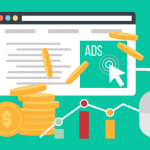It would be ideal to have visitors click on your ads and then buy your products. But if there is one truth about marketing, it is that lead conversion is a laborious process. Visitors do not miraculously appear on your website, browse through the products and make a purchase. Such a feat is not even instantaneous, even with an aggressive social media campaign. A successful marketing strategy is only possible when you know exactly what the customers want. And, yes, this can be a very challenging task.

Good thing that there is attribution modeling to help marketers get through the most common roadblock in marketing—knowing what works and what is not rewarding you the most out of your marketing efforts.
On this note, let’s explore another option that is unarguably the best solution, especially if you are starting a business or are new to digital marketing. Learning about attribution modeling is advantageous if you want to conserve as much time and resources as possible with your marketing.
What Is Attribution Modeling
Today’s marketing standards demand covering as many touchpoints as possible in the customers’ journey. This is doable, but only if you have the time and plenty of resources for a huge marketing budget.
Consumers are now astute with online shopping. They are not instantly convinced by a single ad they see about a product. They tend to spend time researching and comparing products and brands before purchasing. They also do it across devices and visit the website several times.
In the simplest of words, attribution modeling is a set of rules to determine how clicks, conversions, and sales are given credit using analytics tools. It gives you a holistic view of all advertising efforts. You can evaluate which keywords, ads, content, and other campaign materials drive the most value with attribution modeling.
Before diving deeper into the world of attribution, it would also help if you know what the different types of interaction that are counted in attribution are. The four major categories of interactions are the following:
- Direct – The user visits your website by typing the URL without any other interactions in the marketing mix.
- Organic – The user searches for your company or a relevant industry then the search engine shows relevant sites to choose from. When a user clicks your link, it is called an organic search link.
- Paid Ads – This cost-per-click basis ad strategy counts the traffic from paid advertising posted on websites, social media pages, and others.
- Referral – A referral link is any non-direct traffic from search engines, websites, and online articles.
These interactions are the methods by which customers find your website, learn about your products, and eventually make a sale. Generally, these interactions happen as a result of your marketing efforts. Attribution lets you see which of these interactions drive the most leads and conversions so you can decide which channels you should invest your marketing budget.
The Benefits of Attribution Modeling
B2b marketing attribution is popular among marketers because it benefits the organization in many ways. Among the advantages of attribution, these three stands out the most:
- Provide more profound insight into the customer journey. There is a lot of valuable data across the entire sales cycle. Leads can have as many as 20 touch points before converting into customers. With that number, it will be impossible for you to pinpoint which touchpoint is doing great at converting without proper b2b attribution.
- Reduce costs on underperforming strategies. Monitoring clicks, traffic, and time spent on the website are not enough if your goal is to increase your revenue. Attribution modeling gives more information about each touchpoint. This means you can identify the most profitable campaigns to let go of those not doing well for your company.
- Provide a report on marketing success. Most b2b attribution software are designed to generate detailed reports about your attribution efforts. You have complete control over determining the most successful touchpoints in your marketing. You can use the data gathered to devise a more optimized set of marketing campaigns in the future. With detailed reporting in place, you can finally justify marketing budgets and remove all guesswork about how your campaigns will be effective at increasing ROI.
In a nutshell, attribution modeling is essential because the only way to prove ROI is to track your campaigns properly. It is easy to say that your ads, for example, are the reasons for your sales. However, it can be confusing to tell which one made you a profit if you have a lot of campaigns. All credit may be given to your ads, disregarding the roles played by social media marketing, email, and other content in your sales.
If you are unaware of the attribution model used by your analytics software, you may be deceived by the results of your metrics. To know the value of all touchpoints in your campaign, it is best to understand the different types of attribution models.
Types of Attribution Models
Attribution modeling removes the confusion most marketers encounter when determining what strategy works best for the company. An attribution model is like a tool to analyze which touchpoints are responsible for the sales. It helps, but the process can be a bit complex considering that there are a handful of attribution model types to choose from.
There are several attribution models commonly used in marketing, including:
1. Single-touch Attribution Models
Under this category, you either have the first-touch attribution or the last-touch attribution.
- First-touch Attribution – In this model, 100% of the ROI credit is given to the first interaction with the customer. For example, if the customer finds your business on a Facebook post, it gets all of the credit if a sale happens after that interaction. It will not matter if the customer clicks an ad a few days after seeing the post and before making a purchase. It is that Facebook post that will get the full credit.
- Last–touch Attribution – As this model’s name implies, the ROI credit is given 100% to the last interaction with the customer before conversion. It disregards the customer’s other touchpoints and counts only the last interaction before purchasing.
The first and last-touch attribution models are the simplest to implement and evaluate. Its most significant downside is that you will have to ignore many interactions before the first and last touchpoints. This makes a single-touch attribution only useful for short buying cycles where there are only a few touchpoints in the sales funnel.
Multiple-touch Attribution Models
This aims to credit each touchpoint across the customer journey. The amount of credit will depend on the importance of the touchpoint based on the attribution model being used:
- Linear Attribution – The ROI credit is split between each interaction before the purchase. It does not matter how many touchpoints there are and how long the elapsed time is. Equal credit for the conversion will be attributed in all channels.
- Time-decay Attribution – While it may seem similar to the linear model since it gives value to all touchpoints, the time-decay attribution model also considers the touchpoints nearest to conversion as the most important. In this case, the last interaction gets the most credit while the first receives the least.
- U-Shaped Attribution – Unlike in the time-decay model, where only the final touchpoint has the highest ROI credit, the U-shaped model gives 40% credit each on the first and last interactions. The remaining 20% is split between the touchpoints in the middle.
- W-Shaped Attribution – The W-shaped attribution model considers the mid-funnel touchpoint to be as important as the first and last touchpoints, so they share the highest ROI credit. The rest of the touchpoints will have equal credits of the ROI.
- Custom Attribution – Nobody knows your business as well as you do. It is only fitting to have an option to customize an attribution model according to which touchpoints you consider the most important. It can be challenging to create and may require a lot of analysis for the vast amount of data to be processed. Nonetheless, a custom attribution model will give the most detailed reporting about your marketing metrics.
As you can see, these attribution models have a diverse way of distributing the value of a conversion from each touchpoint. Understanding the different attribution models is crucial because they help you gain the most important values to look out for when determining the impact of your marketing.
Conclusion
Spending time to educate yourself about attribution modeling is one of the most effective ways of avoiding a plateau in your marketing strategies. Understanding how each touchpoint performs and how much revenue they generate is essential since it is how you can make smarter decisions in marketing your business.






